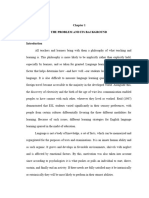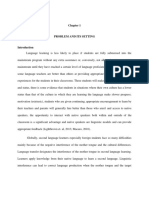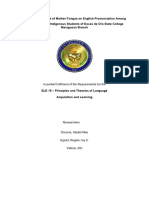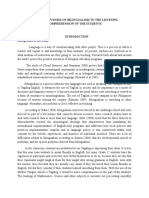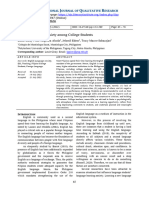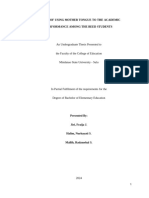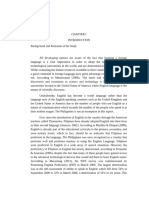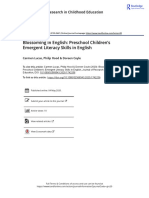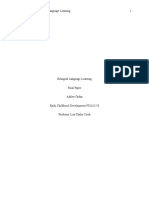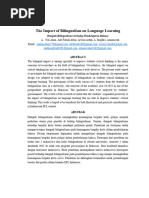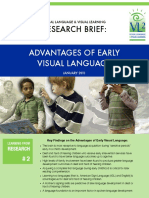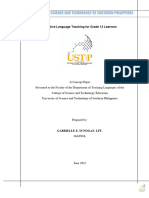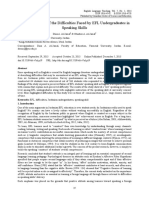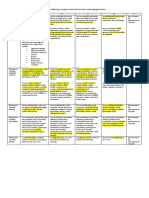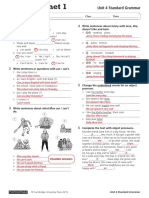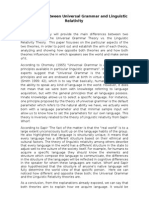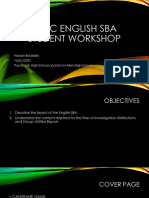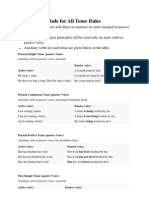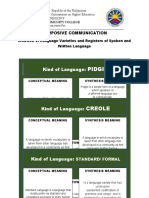English Language Proficiency Profile: A Case Study of The Communication Skills of Deaf Students in The Undergraduate Program in Quezon, Philippines
English Language Proficiency Profile: A Case Study of The Communication Skills of Deaf Students in The Undergraduate Program in Quezon, Philippines
Uploaded by
janah bea ValdezCopyright:
Available Formats
English Language Proficiency Profile: A Case Study of The Communication Skills of Deaf Students in The Undergraduate Program in Quezon, Philippines
English Language Proficiency Profile: A Case Study of The Communication Skills of Deaf Students in The Undergraduate Program in Quezon, Philippines
Uploaded by
janah bea ValdezOriginal Title
Copyright
Available Formats
Share this document
Did you find this document useful?
Is this content inappropriate?
Copyright:
Available Formats
English Language Proficiency Profile: A Case Study of The Communication Skills of Deaf Students in The Undergraduate Program in Quezon, Philippines
English Language Proficiency Profile: A Case Study of The Communication Skills of Deaf Students in The Undergraduate Program in Quezon, Philippines
Uploaded by
janah bea ValdezCopyright:
Available Formats
INTERNATIONAL JOURNAL OF EDUCATIONAL MANAGEMENT AND
DEVELOPMENT STUDIES
Volume 1, Issue 1 · September 2020 · ISSN 2719-0633 (PRINT) 2719-0641 (ONLINE)
ENGLISH LANGUAGE PROFICIENCY PROFILE: A CASE
STUDY OF THE COMMUNICATION SKILLS OF DEAF
STUDENTS IN THE UNDERGRADUATE PROGRAM IN
QUEZON, PHILIPPINES
Mary Rose Q. Cabreros, MDC
Dalubhasaan ng Lungsod ng Lucena, Lucena City, Philippines
mqcabreros16@gmail.com
Abstract
Language acquisition may come naturally for people without sensorial disabilities. But for
deaf children, language acquisition happens differently and comparably delayed than hearing
children. This case study made an in-depth inquiry of the communication skills of the Special
Education (SPED) students in one of the community colleges in Quezon Province,
Philippines. An English Proficiency Test in the areas of Vocabulary, Grammar, Reading
Comprehension, Analysis (Cause and Effect; Making Inferences) and Following Directions
was given to the students. A Focus Group Discussion (FGD) was also conducted to gather
data regarding problems encountered in their English classes. The gathered data were
tabulated using frequency and percentage for the English Proficiency Test, while
Conversation Analysis for FGD. The English Proficiency results revealed that Vocabulary,
Reading Comprehension and Making Inferences were the three key areas where the
respondents exhibit the lowest skills. These facts point out that teaching methods need to be
adjusted to suit the needs of the SPED learners because the deaf’s language formation is
different in nature with that of the hearing. Thus, the researcher strongly recommends
crafting a separate curriculum for the SPED students of the college.
Keywords: special education, language proficiency, sign language, D/HH
A Publication of the Institute of Industry and Academic Research Incorporated 20
www.iiari.org
INTERNATIONAL JOURNAL OF EDUCATIONAL MANAGEMENT AND
DEVELOPMENT STUDIES
Volume 1, Issue 1 · September 2020 · ISSN 2719-0633 (PRINT) 2719-0641 (ONLINE)
1. Introduction
Language is a central element to learning, as one cannot communicate understanding
of a certain subject if there is no comprehension of language in any form. Language
acquisition may come naturally for people without sensorial disabilities. But for deaf children
language acquisition happens differently and comparably delayed than hearing children.
Results in a study conducted by Campbell et. al. (2007) have indicated that the deaf use the
same brain regions to process sign language as the hearing do when exposed to spoken
English. The delays in language acquisition in deaf children translate prominently in their
communication skills and thus have a distinct effect in their learning. Because of their
language delays deaf learners also exhibit delays in their social cognition skills which are
integral in how a student copes in his academic environment. In reading for instance, skills in
social cognition allow a child to understand the perspective of different characters (Schick,
2014).
Language delays evident in deaf learners are attributed to the equally apparent poor
academic performance of majority of them. Similar to hearing children a deaf child’s first
exposure to language is important in his development. It is unfortunate however, that
vocabulary development for deaf children is extremely delayed. Learning in a mainstream set
up may add to the pressure to come up with the language proficiency levels of their hearing
peers in class.
The same holds true for the 23 deaf learners enrolled in the Associate in Computer
Technology program under the BS in Information Technology department in one of the
community colleges in the Quezon Province in the Philippines. Coping with the day to day
tasks of fitting into the academic environment of a mainstream class is already a challenge.
Let alone, passing their subjects particularly in English. Deaf learners in the BSIT-Special
Education (SPED) program of the college attend all their classes mainstreamed with the
hearing. The instructors handling the classes are all hearing, with the exception of only two
instructors (also hearing) who serve as interpreters for all their classes. These interpreters are
the only support service provided by the college for the deaf learners. One interpreter is
assigned for one group who accompany them in all classes throughout the day to assist in all
the lectures.
A Publication of the Institute of Industry and Academic Research Incorporated 21
www.iiari.org
INTERNATIONAL JOURNAL OF EDUCATIONAL MANAGEMENT AND
DEVELOPMENT STUDIES
Volume 1, Issue 1 · September 2020 · ISSN 2719-0633 (PRINT) 2719-0641 (ONLINE)
These deaf learners barely pass their English subjects. And even if they do pass, it is
mostly out of humanitarian reasons extended by the instructor. Their language delays
attributed by their hearing impairment, and most probably the lack of proper support services
for deaf learners may contribute to their difficulty in passing their classes, particularly their
English subjects. To be able to provide the proper support services or device measures to
augment the special needs of deaf learners, one must first study and understand their unique
needs, by identifying first how they developed their acquisition of the English language as
well as their English language proficiency.
This study assessed the English proficiency profile of the SPED students. On a
general standpoint, the study profiled the proficiency levels of the SPED students. In
addition, the unique needs of these deaf learners and learning differences with hearing
students were assessed through a focused discussion on the problems in learning English in
their English classes. As an offshoot of this case study, the researcher hopes to come up with
appropriate measures to enhance the language learning of deaf students as well as suggest
possible support services that may augment the gaps in their academic performance
particularly in their English classes.
2. Literature Review
No other theory perhaps has the most ramification in how D/HH children acquire
their language skills than Theory of the Mind (ToM). Piaget (1965) hinged of a similar view
to that of ToM. However, the rudiments of taking into account the science of the mind began
during the time of Descartes Second Mediation, where ToM’s philosophical roots was first
discussed. Theory of the Mind is “an important social cognitive skill” (Cherry & Gan, 2020)
that entails the ability to equate mental states – that of their own and of others. These mental
states include beliefs, intents, desires, pretending, knowledge, etc. In other words, it is
understanding how and why people feel and behave in a certain way, or having an integrated
set of concepts underlying the understanding of the mind. At around the ages of 4-5, ToM
normally develops for hearing children. However, for D/HH studies indicated that the
language delays they experience also cause delayed understanding of ToM.
A Publication of the Institute of Industry and Academic Research Incorporated 22
www.iiari.org
INTERNATIONAL JOURNAL OF EDUCATIONAL MANAGEMENT AND
DEVELOPMENT STUDIES
Volume 1, Issue 1 · September 2020 · ISSN 2719-0633 (PRINT) 2719-0641 (ONLINE)
A considerable number of studies postulate that D/HH children delays in ToM are
directly related to their language delays. Schick (2014) revealed in their study that the delays
in the ToM skills of D/HH children also translate to their skills involving verbal tasks and
even those that require minimal language. Similar findings on the weakness of ToM among
the deaf were revealed in the study of Fox and Falk (2019). Further, research in the last two
decades pointed out that it is language deprivation and not auditory absence that cause ToM
delays among the D/HH children. Parental participation in the language development is then
considered a decisive factor in how well the child develops language skills. The same effect
is evident in language acquisition whether the child is born from deaf or hearing parents.
Likewise, there is noteworthy evidence that deafness has long-term effects in language
acquisition, which is a fact both for spoken or signed language.
Another theory that explains the language acquisition is the Nativist theory
popularized by Noam Chomsky (1965). This theory posits that in language acquisition,
humans have a set of rules embedded in their heads from birth. It simply means that humans
acquire language skills not entirely through learned experiences, but also through an innate
knowledge, already present within their systems. The same argument was pointed out by
Pinker (1994) when he said that human language is a biological –adaptation language
hardwired into one’s mind by evolution. However, Hall, Hall & Caselli (2019) posited the
Language Scaffolding Hypothesis which states that language deprivation can compromise the
proficiency in a child’s language capabilities that in turn cause delays in their cognitive and
socio-emotional development. Therefore, a D/HH child needs to acquire mastery of any
spoken or signed language to reach optimal development.
Parental factors and the choice of language used by the family of a D/HH child also
figures prominently in their language acquisition. In a study conducted by Csizer and Kontra
(2020) throughout the world there are approximately 90-95% of D/HH children that are born
to hering parents. In addition, Marschark et al. (2015) found in a study that D/HH children
born from parents who continually communicate to them from an early age are those who
perform best in school. According to Easterbrooks & Stoner (2006), however, many of them
face difficulty in thought-formation in spoken language both at home and in school. Due to
this, D/HH children fall behind in academic areas such as reading, spelling and writing
A Publication of the Institute of Industry and Academic Research Incorporated 23
www.iiari.org
INTERNATIONAL JOURNAL OF EDUCATIONAL MANAGEMENT AND
DEVELOPMENT STUDIES
Volume 1, Issue 1 · September 2020 · ISSN 2719-0633 (PRINT) 2719-0641 (ONLINE)
(Turnbull et. al., 2009). The three general areas where D/HH children encounter reading
problems in particular, are in vocabulary, syntactic and figurative language. This goes the
same for spoken language rules where the D/HH have compromised access compared to
children with normal hearing. Heward (2012) states that undoubtedly, this is a multifarious
phenomenon that distresses a person’s academic performance. For this same reason, Rowh
(2006) postulates that deafness affects a person’s communicative abilities and in turn
adversely affects the potential academic and vocational success of an individual.
Deafness also affects literary behavior. Due to the distinctive language situation of
deaf children their literacy behaviors, particularly their book orientation is affected. This is
according to a study conducted in the Philippines by Bustos in 2007. Because of the absence
of audition, these deaf children are devoid of phonemic cognizance, despite being able to
identify and match letters. Thus they are more picture-governed than print-governed. Same
conclusions were derived in a study conducted by Obosu, Opoku-Asare & Deku (2016) in
Ghana where subjects where subjects delivered in English language had serious impact on a
D/HH child’s academic success.
It is apparent that language delays experienced by D/HH students directly affects their
language proficiency and ultimately their academic performance. Deaf children are not just
having difficulty with linguistic delays, according to Howerton-Fox & Falk (2019), their
perception and language development are likewise affected due to language deprivation. And
this effect may possibly be permanent. Student’s literacy development may be an equally
difficult process especially for students with intricate linguistic histories. On the other hand,
D/HH students exhibit strong proficiencies in literacy areas at par with hearing peers,
particularly in written expression discourse and phonological cognizance (Bowers et. al/,
2018). Scott & Dostal (2019) added that at the macro-level deaf children exhibited at par
performance with their hearing peers, but poorer in micro-level narrative skills, and when it
comes to the implicative questions they showed less relevant and detailed answers when
compared to their hearing peers.
As in any learning environment there are factors that dictate the efficacy and success of
the teaching-learning process. In language learning, whether for hearing or D/HH students
certain factors such as instruction, curriculum, teacher standards, materials, facilities, support
A Publication of the Institute of Industry and Academic Research Incorporated 24
www.iiari.org
INTERNATIONAL JOURNAL OF EDUCATIONAL MANAGEMENT AND
DEVELOPMENT STUDIES
Volume 1, Issue 1 · September 2020 · ISSN 2719-0633 (PRINT) 2719-0641 (ONLINE)
services and the like are considered in order to meet the learning requirements needed. For
Domagała-Zyśk (2016), understanding that for the D/HH, the key difficulties revolve not just
in the constrained to non-existent possibility of auditory access to language, but foremost is
attaching meaning to the words and expressions used. It is thus suggested by Rosa-Lugo &
Ehren (2018) to revisit the intense literacy strains brought about by laborious standards,
curriculum, instruction, and assessment that have serious effects to children and adults with
hearing loss learning English as a second spoken language. In most English classes for
example, speech, speech-reading and listening are means of communication in native
languages only for some D/HH people. Distinctive external conditions that would help D/HH
students learn better such as good visibility, good quality of the speaker’s speech and the
absence of background distractions should be present in the learning environment.
Domagala-Zysk & Kontra (2016) however argues that these conditions are not easily met,
specifically in mainstream classrooms. In the design of suitable teaching methodologies, the
consideration of which areas in English language pedagogy should not be the only concern.
Rather it should be given more importance as to how educators should approach these
pedagogies in ways that would develop the optimal language skills of the D/HH. As Sollestra
(2011) pointed out that there should be a visual modality that matches perfectly the absence
of hearing.
3. Methodology
The study used quantitative and qualitative designs. The former was used in the
testing of the English proficiency level while the latter on the challenges encountered in
learning the language. The researcher used total enumeration of the 23 SPED students of the
Associate in Computer Technology program under the BS in Information Technology
department.
To come up with the data for the English Proficiency level of the respondents, the
researcher administered a self-made language test that measure the following language
capabilities: grammar, vocabulary, reading comprehension, analysis (cause & effect, making
Inferences) and following directions. To check the validity of the test, the researcher enlisted
the expertise of a licensed language instructor as well as the advice of a sign language trainer
from a local public high school who handles SPED education in the basic education. To
A Publication of the Institute of Industry and Academic Research Incorporated 25
www.iiari.org
INTERNATIONAL JOURNAL OF EDUCATIONAL MANAGEMENT AND
DEVELOPMENT STUDIES
Volume 1, Issue 1 · September 2020 · ISSN 2719-0633 (PRINT) 2719-0641 (ONLINE)
gather data regarding the problems they encounter in learning language in their English
subjects, a FGD was conducted with the guidance of the two sign language interpreters and
in the presence of the sign language trainer to help analyze the data and correspondence of
the discussion. The researcher utilized the following data collection tools: Video Recorder
(for FGD session), Anecdotal Records (brief notes on the highlights of each observation
session or interview) and Basic Information Sheet or Student Records.
The data gathering was conducted on the month of April, during the 2nd semester of
School Year 2014-2015 with an actual test given to the students. The first part of the test was
the grammar and vocabulary test. Each respondent was handed a written test consisted of 20
items in vocabulary and 20 items in grammar, totaling 40 items. They were given an hour to
complete the test.
The second part of the test was for reading comprehension, analysis and following
directions. For reading comprehension, a reading material was flashed on a MS PowerPoint
presentation and afterwards multiple choice questions were flashed for them to answer. They
wrote their answers on a sheet of paper. This was followed by another written exam with two
parts: determining cause and effect and making inferences from a short story. A matching
type test was given to the respondents where they matched the causes enumerated in column
A to the effects in column B. Answers were again written in their answer sheets. For the
making inferences part, the researcher read a short story to the respondents while an
interpreter signs to the students. The story was also flashed on screen. When the story
reached the near end, the researcher asked the respondents what they think happened in the
end. They again wrote their answers in their answer sheets. Finally for following directions,
the researcher asked the respondents to follow the direction flashed on screen. They were
asked to read carefully each of the 10 following direction items before they wrote/did what
was asked.
The researcher also conducted a FGD to gather data regarding the problems
encountered by the SPED students in their English classes. The discussion was guided by the
two (2) SPED interpreters. A set of questions were asked to the students and the group
discussed the answers with the help of the interpreters. A sign language trainer was present to
interpret and analyze the discussion. The FGD focused on four different key points: Teacher
A Publication of the Institute of Industry and Academic Research Incorporated 26
www.iiari.org
INTERNATIONAL JOURNAL OF EDUCATIONAL MANAGEMENT AND
DEVELOPMENT STUDIES
Volume 1, Issue 1 · September 2020 · ISSN 2719-0633 (PRINT) 2719-0641 (ONLINE)
–Deaf student relationship, Teacher knowledge on “how deaf students think and learn”,
Involvement of parents / family and Teacher-learning strategies intervention.
The results from the English proficiency test in grammar and vocabulary were tallied
and analyzed through frequency and percentage. After determining the mean scores, the
frequencies were also derived to come up with the number of respondents who fell under the
specific set of scores correlated with value interpretation. The researcher based the value
interpretations from the rating scale utilized by the college in the computation of student
grades. Based on the said scale the researcher set the following value interpretation for the
results of the English Proficiency tests used in the study:
Score (5 items) (10 items) (20 items) Value Interpretation
1 – 1.99 1 – 2.99 11 & below Needs Improvement
2 – 2.99 3 – 4.99 12 - 14 Fair
3 – 3.99 5 – 6.99 15-16 Good
4 – 4.99 7 – 8.99 17-18 Very Good
5 9- 10 19 - 20 Excellent
Meanwhile, data from the focus group discussion were analyzed using Conversation
Analysis. The researcher focused on the five features identified as being regular parts of
conversation within the framework of CA— openings, turn taking, adjacency pairs,
repairs, and closings. Said features were outlined in the milieu of conversations that occur
between the researcher, the deaf respondents and the interpreter. A brief description of each
feature was given within the analysis.
To aid the researcher in analyzing both the context and the prosodic or non-verbal
cues in the discussion, the discourse was transcribed using selected key transcription symbols
to illustrate the prosodic and timing cues that occurred in the discussion.
A Publication of the Institute of Industry and Academic Research Incorporated 27
www.iiari.org
INTERNATIONAL JOURNAL OF EDUCATIONAL MANAGEMENT AND
DEVELOPMENT STUDIES
Volume 1, Issue 1 · September 2020 · ISSN 2719-0633 (PRINT) 2719-0641 (ONLINE)
Item Symbol Definition Transcription
Sample
Held segment : A colon indicates that the individual has held
or “stretched” a sign. The more colons, the Yes::
longer the hold.
Pause (.) A dot enclosed in parentheses indicates a
pause in the conversation of less than two- Example (.)
tenths of a second.
Emphasis -------- Underlining indicates an animated or
emphatic segment Must
Latching = An equal sign indicates latching between Ask questions? =
utterances in the conversation. =yes…
Overlapping [] Brackets indicate overlapping talk between [deep words]
talk the individuals. [having difficulty
with
understanding…]
Non-verbal (( )) Double parentheses indicate prosodic or
activity nonverbal activity. (( nodding))
Using the symbols in transcribing the discussion, the researcher was able to analyze
not just the context of the conversations but also the underlying explanations of the thoughts
and emotions of the respondents as they answered each inquiry. Through the help of the
invited sign language trainer, a further interpretation and evaluation of the process was
provided to determine if the purpose of the discussion was achieved.
4. Results and Discussion
1.1.English Language Proficiency Profile
Table 1 shows the frequency count of the test scores obtained by the students in the
English Language proficiency tests.
A Publication of the Institute of Industry and Academic Research Incorporated 28
www.iiari.org
INTERNATIONAL JOURNAL OF EDUCATIONAL MANAGEMENT AND
DEVELOPMENT STUDIES
Volume 1, Issue 1 · September 2020 · ISSN 2719-0633 (PRINT) 2719-0641 (ONLINE)
Table 1
Results of the English Language Proficiency Tests and their Interpretation
Vocabulary Grammar Reading Cause Making Following
and Inferences Directions
Effect VI
Scores F % F % Scores F % F % F % Scores F %
11 &
14 61% 9 39% 0 -1.99 10 43% 8 35% 14 61% 1 – 2.99 0 0% NI
below
12 - 14 5 22% 10 43% 2 – 2.99 7 3% 2 9% 5 22% 3 – 4.99 8 40% F
15 - 16 3 13% 2 9% 3 – 3.99 4 17% 3 13% 4 17% 5 – 6.99 1 0% G
17-18 0 0% 2 9% 4 – 4.99 2 9% 1 4% 0 0% 7 – 8.99 9 40% VG
19 - 20 1 4% 0 0% 5 0 0% 9 39% 0 0% 9 - 10 5 20% E
Legend: NI = Needs Improvement; F = Fair; G = Good; VG = Very Good; E = Excellent
As to the vocabulary test, 14 respondents (61%) fell below the mean score,
corresponding to a value interpretation of Needs Improvement. There were 8 respondents
who got scores above the mean and got value interpretations of Fair and Good. Meanwhile,
one respondent obtained the highest score in the test, 19 out of the 20-item vocabulary test,
interpreted as Excellent. Considering that most of the materials chosen for the test were
below college level English, the result still shows most of the respondents display below
average skills with poor grasp of English words.
Based on the tallied scores for the grammar test, 9 out of the 23 respondents scored
below the mean and got a value interpretation of Needs Improvement. Whereas there were
two respondents who displayed above average grasp of the English grammar garnering
scores 17 - 18 with a value interpretation of Very Good. Compared to the vocabulary test,
there was a significant improvement in the results acquired by the respondents in the
grammar test.
The results of the reading comprehension test show that majority of the respondents,
specifically 43%, fell below the mean score and got a value interpretation of Needs
Improvement. About 11 respondents showed average levels of reading comprehension and
got scores above the mean, with a Fair and Good value interpretation. Finally, there were
only 2 respondents who obtained a score of 4 out of the 5-item reading comprehension test
equivalent to Very Good. It is clear from the results, that most of the respondents exhibit very
A Publication of the Institute of Industry and Academic Research Incorporated 29
www.iiari.org
INTERNATIONAL JOURNAL OF EDUCATIONAL MANAGEMENT AND
DEVELOPMENT STUDIES
Volume 1, Issue 1 · September 2020 · ISSN 2719-0633 (PRINT) 2719-0641 (ONLINE)
low comprehension skills, as the majority of them did not answer more than half of the
questions correctly.
In the cause and effect test, 10 respondents fell below the mean score; 5 of these
respondents, who got a value interpretation of Needs Improvement, got a score of 0.
Meanwhile, 39% of the respondents got a perfect score of 5, with a value interpretation of
Excellent.
In the making inferences test, 14 or 61% of the respondents fell below the mean,
getting a value interpretation of Needs Improvement. This indicates that majority of them,
have very low skills in making inferences from stories. 22% (5 respondents) got scores of 2,
with a value interpretation of Fair and were at least attempted to draw conclusions although
there were inaccuracies in details and unsubstantiated predictions.Only4 respondents who got
scores of 3 were able to draw out somewhat accurate conclusions derived from the story.
However, it still contained inaccurate details and they were not able to write their predictions
in grammatically correct sentences. These respondents got a value interpretation of Very
Good.
Lastly, the following directions test scores show that the respondents showed the
highest proficiency, as there were 15 respondents whose scores were above the mean. Only
about 35% (or 8 respondents) fell below the mean score. The results of the Following
Directions test indicate that compared to the other areas of the test, this is where the
respondents display a relatively average capacity in understanding and following
instructions.
Table 2 shows the summary of mean scores of all the five areas tested with their
corresponding value interpretations. Overall results show that only the ‘Following
Directions’ test got an impressive 6.13 mean score interpreted as Good. The areas Grammar
and Cause & Effect Analysis both with ‘Fair’ equivalence of their mean scores of 11.91 and
2.82, respectively. Three of the six items fell on the lowest scale ‘Needs Improvement which
include vocabulary (10.86 mean score), reading comprehension (1.6 mean score) and making
inferences (1.56 mean score).
A Publication of the Institute of Industry and Academic Research Incorporated 30
www.iiari.org
INTERNATIONAL JOURNAL OF EDUCATIONAL MANAGEMENT AND
DEVELOPMENT STUDIES
Volume 1, Issue 1 · September 2020 · ISSN 2719-0633 (PRINT) 2719-0641 (ONLINE)
Table 2
Summary of mean scores and mean level performance
Areas of English Proficiency Mean Score Value Interpretation
1. Vocabulary 10.86 Needs Improvement
2. Grammar 11.91 Fair
3. Reading Comprehension 1.6 Needs Improvement
4. Analysis (Cause & Effect) 2.82 Fair
5. Analysis (Making Inferences) 1.56 Needs Improvement
6. Following Directions 6.13 Good
The three areas with lowest proficiency seemingly attributed to their limited grasp for
English words. This may contribute to the fact that it seems difficult for majority of them to
comprehend reading materials. That in turn also shows why they also have below average
skills in predicting outcomes or drawing out conclusions from a story. Their results likewise
show a relatively higher proficiency in grammar as compared to their vocabulary skills.
While they show below average skills in making predictions, as far as analysis is concerned,
they are more able to evaluate cause and effect relationships. The study also showed that
their highest skill appears to be in following directions as this is where they obtained the
highest scores in the whole test.
The results of the English Proficiency tests indicate that the respondents acquired low
proficiency scores more particularly apparent in the Vocabulary, Reading Comprehension
and Making Inferences part. Although they did show slightly higher proficiencies in the areas
of Grammar, Cause and Effect and Following Directions, the results do not show a
proficiency in English that matches that of a college student. However, it must be considered
that the respondents have sensorial disabilities that inhibit them to acquire language skills
like that of a hearing student. The results will consequently render an English Language
Proficiency Profile indicating their strengths and weaknesses in the English language.
Beyond what the profile reveals, there should also be an understanding on the reason
why they have delays in language development that is subsequently reflected in their
performance in the tests. It is interesting to note how the respondents reacted while taking the
A Publication of the Institute of Industry and Academic Research Incorporated 31
www.iiari.org
INTERNATIONAL JOURNAL OF EDUCATIONAL MANAGEMENT AND
DEVELOPMENT STUDIES
Volume 1, Issue 1 · September 2020 · ISSN 2719-0633 (PRINT) 2719-0641 (ONLINE)
tests. Even with aid of the two interpreters in explaining the test questions, the researcher
observed that they have difficulty grasping some concepts of words unless the interpreters
gave them visual examples. This observation is substantiated by Sollestra (2011) that deaf
people are ‘eye’ people where sign language is considered a ‘visual-gestural language’.
1.2.Problems Encountered In Learning English
This part focused on the five features of regular parts of a conversation in the
framework of CA. An example of the transcription for each feature is discussed including a
brief description. The sample utterances are numbered in the left part to indicate the
sequencing of the turn taking and the abbreviations R, refers to the researcher, I1 refers to
the male interpreter, I2 refers to the female interpreter and RES refers to
“respondents”.
A. Opening
This is the part where the conversation or the discussion starts. In the CA framework,
there are various core sequences in opening a conversation. The sequence used in this
particular FGD is called a “summons answer”, where an individual poses a question or offers
a leading statement to begin the conversation. The FGD opened with the researcher
explaining what the discussion is about and how it will transpire. It should be noted that
before the actual filming the researcher explained to the two interpreters and the sign
language trainer how the researcher will conduct the discussion. The transcription provided
below occurred after the filming began.
O1 R: So (.) this morning (.) we will discuss some possible problems that you may
encounter in learning the English language, in your English classes.
So I’m going to ask you questions regarding this. Anybody can answer if
you want. Raise you hand(( raises hand to show to respondents)) if you
want to answer ok ::
02 I1: (( signs the instructions to respondents))
03 R: ((researcher looks at interpreter to see if she can begin asking questions))
A Publication of the Institute of Industry and Academic Research Incorporated 32
www.iiari.org
INTERNATIONAL JOURNAL OF EDUCATIONAL MANAGEMENT AND
DEVELOPMENT STUDIES
Volume 1, Issue 1 · September 2020 · ISSN 2719-0633 (PRINT) 2719-0641 (ONLINE)
In the discussion, the researcher opened by explaining to the respondents what the
discussion is about and how the discussion will be conducted. There were already a few
pauses from the opening of the discussion which indicates that the researcher is being careful
in trying to start the conversation with the respondents. The researcher deliberately chose to
give a brief opening so that the respondents can easily comprehend. It was also evident that
there were parts stressed, for instance emphasizing that the discussion is focused on their
English class, and emphasizing instructions through actions. The researcher also looked at
the interpreter before starting the questions as verbal cues would come from the interpreter.
B. Turn Takings
One of the more important features of CA is how turn takings unfold in a discussion.
Turn taking simply put, is the completion of an utterance of one individual involved in the
discussion to give way to another. A “turn” is signaled either by a simple word or signal, a
long sentence or a series of utterances that lasts for several minutes or prosodic cues. There
were many points of turn taking in the discussion. Instead of a simple 2-way conversation
however, the turn takings involved the researcher, the interpreter (either of the two
interpreters present) and the respondent. The researcher addressed the question to the
respondent, the interpreter asked the question through sign language to the respondent, and
the interpreter relayed the answer to the researcher.
01 R: So:: do you think you are able to understand you work better in English
Sa mga English assignments nyo pag (.) yung parents or yung family ang
nagtuturo(.) mas naiintindihan nyo ba siya? (.) or :: [ay yundaw] ((points at
one respondent))
02 I1: [yes, yes] ((signs getting answers from respondents))
03 R: yes? Yes? Ahh:: bakit? Bakit mas naiintindihan pagka (.) magulang or
family angnageexplainsa English? :: ((waiting for reply))
A Publication of the Institute of Industry and Academic Research Incorporated 33
www.iiari.org
INTERNATIONAL JOURNAL OF EDUCATIONAL MANAGEMENT AND
DEVELOPMENT STUDIES
Volume 1, Issue 1 · September 2020 · ISSN 2719-0633 (PRINT) 2719-0641 (ONLINE)
04 I1: ((interprets question through sign))same meaning, Ahh :: ((nods))
saenglish, parangnatututunan : ((trying to understand sign reply of
respondents))
I1: with my parents…as the mother…or the mother signs very well. [I can
understand it]
R: [ah…in her case] her mother signs [very well]
05 I1: [oo] ((nods and signs to respondent)) maalamang mother mag sign ((nod))
It was quite expected that there were many non-verbal activities or prosodic cues
when communicating with the deaf. Aside from the interpretation relayed by the interpreter
regarding their replies to the question, the only way the researcher can understand their
thoughts was through their facial expressions while they are signing. Although it was
noticeable that turn taking took place more between the researcher and the interpreter, there
were cues that the researcher took from the respondents themselves. This is why the
researcher looked at the respondents intently while asking the questions or waiting for their
answers. There were also quite a number of overlapped utterances between the researcher
and the interpreter, indicating that one individual did not wait for the other to finish. It would
be evident from the transcription that it was the researcher who often expresses her utterances
hastily.
C. Adjacency Pairs
Adjacency pairs are pairs of utterances that are ordered; that is, there is a recognizable
difference between the first part and the second part of the pair. Examples of this are question
and answers, greetings and return greetings and invitations and acceptance / declinations.
There were certain but very seldom points in the discussion that featured adjacency pairs,
mostly because the discussion involved many participants. But there were points when the
conversation was between the researcher and one of the interpreters.
01 R: Napapansin nyo ba kung (.) yung activities or yung lessons ay (.) ((gestures
with hands)) naadjust? ((turns to I2 and waits for reply))
Uhhm…english, English (.) ke Mam Alice it is adjusted…Oo? (.)
A Publication of the Institute of Industry and Academic Research Incorporated 34
www.iiari.org
INTERNATIONAL JOURNAL OF EDUCATIONAL MANAGEMENT AND
DEVELOPMENT STUDIES
Volume 1, Issue 1 · September 2020 · ISSN 2719-0633 (PRINT) 2719-0641 (ONLINE)
Meron? Example, example, paano example?
02 I2: Mga play nila….
03 R: Ano pong difference pagsa SPED?
04 I2: Yung kanila (.) yung based on (.) yung naranasan na nila sa lesson para
madali na maka cope.
05 R: Uhhhmm??:::
In this transcription it appeared that the long pause at the end of their conversation
indicated that the researcher was quite confused with the answer of the interpreter. The reply
did not clearly explain what the researcher was asking the interpreter. The tone at the end
implied that clearly the researcher still has questions.
D. Repairs
Repairs refer to how individuals in conversation deal with challenges in speaking,
hearing, or understanding. Repair segments are classified by who initiates repair, by who
resolves the problem, and how the repair unfolds within a turn or a sequence of turns. In the
discussion, there was a point in the beginning, where the researcher felt frustrated that the
respondents did not seem to be reacting to the questions. The researcher felt that the
questions were not being clearly relayed. In an attempt to repair the situation, the researcher
kept on repeating the questions.
01 R: Ano, nag aapproach ba kayo sa teacher? :::: do you approach your teachers
in English pag ahh (.) pag me gusting linawin sa assignments (.) or sa
subject ::: anong reason kung bakit no? :::
02 I1: ((signs while asking and explaining the question))
03 R: Ano daw po….. Kanina ang daming nag raise ng hand ((raises hand to
encourage reaction from respondents))
04 I1: (raises hand to ask respondents))
05 R: You….ano daw? ((looking at I1 and a respondent talk in sign language))
06 I2: sinong may sabing yes? Taas ang kamay ((signs while giving instructions))
Yes?? ((asking respondent though sign)) Ano….oh taas ang kamay!
A Publication of the Institute of Industry and Academic Research Incorporated 35
www.iiari.org
INTERNATIONAL JOURNAL OF EDUCATIONAL MANAGEMENT AND
DEVELOPMENT STUDIES
Volume 1, Issue 1 · September 2020 · ISSN 2719-0633 (PRINT) 2719-0641 (ONLINE)
07 R: ((trying to understand sign conversation of I1 and a respondent)) Ano daw
po Sir?
08 I1: nagtatanong din daw siya::: ((trying to understand respondent)) pero :::
09 R: pero:::
10 I1: deep ang words….
11 R: [Hard]
12 I1: [hard] and vocabulary….
13 I2: [deep and English words]
It was apparent in the transcription that there was a point in the discourse where the
researcher felt frustrated that the respondents were not responding or reacting to the
questions. The researcher kept on asking the questions trying to make the idea clearer for the
respondents. In an attempt to repair the confusion, one of the interpreters tried a more
aggressive approach in making the respondents raise their hand or offer a reaction, while the
other interpreter continued clarifying the questions to the respondents and tried to understand
the reply.
E. Closings
This is the part of the conversation where one individual brings the discussion to an
end. It requires one speaker to directly or indirectly end the conversation. In the closing part
of the discussion, the researcher gave a more detailed explanation why the study was
conducted, the purpose of the study and what can be a possible outcome in the future. The
closing was a bit lengthy so only an excerpt was included here as an example.
01 R: So ::: alright:: So(.) yun lang po…((laughing))…Ang purpose po nung study
(.) gusto ko rin lang po malaman ng mga kids (.) gusto kong malaman yung
level ng proficiency nyo sa English (.) alam naman natin na medyo
nahihirapan kayo sa language (.) mabuti ngayon (.) it’s good that the
teachers in English are able to adjust (.) the lessons…
…..so that’s solely for your English proficiency (.) we want to see ano talaga
level ng ating deaf learners. Para maibigay naman namin yung best service
eventually sa laha ng deaf na mag aaral. Para pag graduate nyo (.) ay (.)
A Publication of the Institute of Industry and Academic Research Incorporated 36
www.iiari.org
INTERNATIONAL JOURNAL OF EDUCATIONAL MANAGEMENT AND
DEVELOPMENT STUDIES
Volume 1, Issue 1 · September 2020 · ISSN 2719-0633 (PRINT) 2719-0641 (ONLINE)
yung level ng communication, yung language, language acquisition, level ng
communication…hopefully we will see an improvement though ::: that
specialized program that we will offer para sa language::: ((smiles to the
respondents))
Ok::: ((laughs)) so thank you very much for taking part in my study…
I1: ((signs to the respondents while researcher talks))
In the closing part of the discussion, the researcher did all the talking while the
interpreter signs. As expected, the respondent’s attention was focused on the interpreter while
the researcher gives the closing. The researcher kept saying the words “ok” and “alright” as a
signal that the discussion has reached its end point.
The videotaped session of the FGD was also viewed by the sign language trainer for
the necessary analysis. These were some of the points stressed in the analysis:
1. The videographer was not able to focus more on the respondents. As a result it did
not show much of the respondents’ actual reactions specially their non-verbal and
prosodic cues that would have helped in better analyzing the respondents’ reactions.
2. It takes time for a deaf student to process any message being relayed to them through
sign. This may explain why the respondents do not get to react or reply immediately
after the researcher asked the question.
3. The questions were asked too fast and too frequent that the respondents got confused.
As a result they do not get to react or reply immediately.
4. It was noticed that interpreters were also taking some time interpreting the questions.
It seemed that the researcher was not able to show the questions to the interpreters in
advance. It was advised that questions should be discussed or at least shown to the
interpreters so they would already be familiar before they interpret it to the
respondents.
5. There was “reverse interpretation”, where instead of signing a particular message or
question to the deaf, interpreters construct the message into an acceptable spoken
message. There are certain parts of speech that have no sign language equivalent.
A Publication of the Institute of Industry and Academic Research Incorporated 37
www.iiari.org
INTERNATIONAL JOURNAL OF EDUCATIONAL MANAGEMENT AND
DEVELOPMENT STUDIES
Volume 1, Issue 1 · September 2020 · ISSN 2719-0633 (PRINT) 2719-0641 (ONLINE)
Based on the proceedings of the FGD, the following concerns were identified under the four
key areas focused in their learning environment:
A. Teacher –Deaf student relationship
Some of the respondents expressed their uncertainty in approaching their English teacher
because they did not understand well the lectures and do not know exactly what to ask.
According to them the words were too “deep” or too “hard” for them to understand.
Although English teachers have adjusted lessons and activities in their classes to make it
easier for the deaf students to cope, according to the deaf students in their third year level,
this was not the case before. Their English teachers back then give the same activities and
employ the same teaching approach to both the hearing and the deaf in the class.
B. Teacher knowledge on “how deaf students think and learn”
The same concern was raised by the same deaf respondents in this area. Because at the
time these students were taking their English classes, the SPED program was still new,
the teachers were still not oriented on how to handle deaf students. It was quite
remarkable that English teachers currently give consideration and exert efforts in trying
to adjust the subject for the deaf students.
C. Involvement of parents / family
Majority of the respondents expressed that they get enough support from their family,
particularly their parents. In fact, they even implied that they find it easier to understand
their assignments in English when their family members help them. There was not much
problem in this area, except for a minority of the respondents who do not have parents
around.
D. Teacher-learning strategies or intervention
For the nine students in their third year level of study, they expressed that it was difficult
for them to cope in their English classes before due to the lack of strategies employed by
English teachers to help them cope in their subject. The activities and lessons were
centered on materials that were designed for hearing students.
A Publication of the Institute of Industry and Academic Research Incorporated 38
www.iiari.org
INTERNATIONAL JOURNAL OF EDUCATIONAL MANAGEMENT AND
DEVELOPMENT STUDIES
Volume 1, Issue 1 · September 2020 · ISSN 2719-0633 (PRINT) 2719-0641 (ONLINE)
5. Conclusion
This case study made an in-depth inquiry of the Special Education (SPED) students in
one of the community colleges in Quezon Province, Philippines. Profiling their English
language proficiency showed that their proficiency is not of college level. The areas in which
they showed the lowest scores in the tests which are vocabulary, reading comprehension and
making inferences clearly point to the expected language limitations of someone with
sensorial disabilities. Meanwhile, they expressed difficulty in coping with the learning
requirements of their language classes which are designed for hearing students. As the
respondents are considered a minority in the college, the learning approaches used by the
instructors are designed for the majority of the student population which are the hearing
students.
The teachers need to understand the nature of their students. In this case, the language
of the deaf is totally different with that of the hearing to begin with. No matter how they try
to make them proficient in the English language, efforts will be futile unless they use an
approach applicable to the D/HH’s own system of English language. For this, the college has
a much bigger responsibility to provide support services for the students with special needs.
These include an appropriate curriculum, teachers training program, differentiated learning
materials and an inclusive class environment. The road to the English language proficiency
of the SPED students is rough but there are ways and means the college can put in place to
achieve the goal.
The results of the current study, given its limited scope and sample size, opened
various related aspects of special education. The exclusion of the English language teachers
for a triangulation approach might have impact on the analysis. Thus, the researcher
recommends further studies that focus on teaching approaches and methodologies and its
effect on the language proficiency of the D/HH students. Further, demographic profile of the
students may be considered as factors for the language proficiency.
A Publication of the Institute of Industry and Academic Research Incorporated 39
www.iiari.org
INTERNATIONAL JOURNAL OF EDUCATIONAL MANAGEMENT AND
DEVELOPMENT STUDIES
Volume 1, Issue 1 · September 2020 · ISSN 2719-0633 (PRINT) 2719-0641 (ONLINE)
References
Bowers, L., Dostal H., Wolbers, K., and Graham, S. (2018), The Assessment of Written
Phrasal Constructs and Grammar of Deaf and Hard of Hearing Students with
Varying Expressive Language Abilities, Hindawi Education Research International
Volume 2018, Article ID 2139626, pp. 1-10
Bustos, M. P. (2007). Exploring Emergent Literacy Behaviors of Filipino Deaf Children.
Retrieved January 12, 2013 from
http://www.dlsu.edu.ph/research/journals/taper/pdf/200706/bustos.pdf
Campbell, R. et. al., (2007), Sign Language and the Brain: A Review, Journal of Deaf studies
and Deaf Education 13:1, 2008, DOI: 10.1093
Chery, K and Gan S. MD, (2020), How the Theory of the Mind Helps Us Understand Others,
Psychosocial Psychology, Very Well Mind, Retrieved August 18, 2020 from
https://www.verywellmind.com
Chomsky, N. (1965). Aspects of the theory of syntax. Cambridge, MA: MIT Press.
Csizer, K. and Kontra, E. (2020), Foreign Language Learning Characteristics of Deaf and
Severely Hard-of-Hearing Students, The Modern Language Journal, 104, 1, (2020),
DOI: 10.1111/modl.12630
Domagała-Zyśk, E. (2016). Vocabulary Teaching Strategies In English As A Foreign
Language Classes For Deaf And Hard-Of-Hearing Students. In Domagala-Zysk, E.
& Kontra, E.H. (Eds.) English as a Foreign Language for Deaf and Hard-of-Hearing
Persons: Challenges and Strategies. UK: Cambridge Scholars Publishing
Domagala-Zysk, E. & Kontra, E.H. (2016). English as a Foreign Language for Deaf and
Hard-of-Hearing Persons: Challenges and Strategies. UK: Cambridge Scholars
Publishing
Easterbrooks, S. R., & Stoner, M. (2006). Using a visual tool to increase adjectives in the
written language of students who are deaf or hard of hearing. Communication
Disorders Quarterly, 27(2), 95–109. doi:10.1177/15257401060270020701
Fox, A. and Falk, J. (2019), Deaf Children as ‘English Learners’: The Psycholinguistic Turn
in Deaf Education, Education Sciences, June 2019, 9, 133; DOI:10.3390
A Publication of the Institute of Industry and Academic Research Incorporated 40
www.iiari.org
INTERNATIONAL JOURNAL OF EDUCATIONAL MANAGEMENT AND
DEVELOPMENT STUDIES
Volume 1, Issue 1 · September 2020 · ISSN 2719-0633 (PRINT) 2719-0641 (ONLINE)
Hall, M., Hall, W. and Caselli, N. (2019), Deaf children need language, not (just) speech,
First Language 2019, Vol. 39, DOI: 10.1177/0142723719834102
Heward, W. L. (2012). Exceptional children: An introduction to special education. Boston:
Pearson Educational Inc.
Howerton-Fox, A. & Falk, J.L. (2019). Deaf Children as ‘English Learners’: The
Psycholinguistic Turn in Deaf Education. Educ. Sci. 2019 2019, 9, 133, pp 1 – 29.
DOI:10.3390/educsci9020133
Marschark, M., Shaver, D.M., Nagle, K.M. & Newman, L. A. (2015). Predicting The
Achievement Of Deaf And Hard-Of-Hearing Students From Individual, Household,
Communication And Educational Factors. Exceptional Children, vol. 81, no. 3, pp.
350–369, 2015.
Obosu, G.K., Opoku-Asare, N.A. & Deku, P. (2016), Access to English Language
Acquisition in Ghana Schools for the Deaf: Are the Deaf Students Handicapped,
Journal of Education and Practice, Vol.7, No.35, 2016, pp. 17-34
Pinker, S. (1994). The Language Instinct: How the Mind Creates Language. Harvard
University Press.
Piaget, J. (1936). Origins of intelligence in the child. London: Routledge & Kegan Paul.
Rosa-Lugo, L. and Ehren, B. (2018), Impact of Escalating Literacy Demands on English
Learners With Hearing Loss, Wolters Kluwer Health, Inc, Vol. 38, No. 3, pp. 171–
193, DOI: 10.1097
Rowh, M. (2006).Write well, go far. Career World, 34(4), 18–21.
Schick, B. (2014) Social Cognition and Theory of the Mind Retrieved January 8, 2014 from
http://www.handsandvoices.org/comcon/articles/socCogTheorMind.html
Scott, J.A. & Dostal, H.M. (2019). Language Development and Deaf/Hard of Hearing
Children. (In) Peter V. Paul. The Education of d/Deaf and Hard of Hearing Children
Perspectives on Language and Literacy Development. Educ. Sci. 2019, 9, 135, pp 22
– 35. DOI:10.3390/educsci9020135
A Publication of the Institute of Industry and Academic Research Incorporated 41
www.iiari.org
INTERNATIONAL JOURNAL OF EDUCATIONAL MANAGEMENT AND
DEVELOPMENT STUDIES
Volume 1, Issue 1 · September 2020 · ISSN 2719-0633 (PRINT) 2719-0641 (ONLINE)
Sollestra, P. (2011). Teaching English for the Deaf from the Eyes of a Hearing Priest.
Retrieved April 6, 2015 from
https://deafphilippines.wordpress.com/2011/11/12/teaching-english-for-the-deaf-
from-the-eyes-of-a-hearing-priest/.
Turnbull, A. P., Turnbull III, R., Shank, M., & Leal, D. (2009). Exceptional lives: Special
education in today’s schools. Englewood Cliffs, New Jersey: Prentice-Hall Inc.
A Publication of the Institute of Industry and Academic Research Incorporated 42
www.iiari.org
You might also like
- MapasDocument5 pagesMapasquel_roqueNo ratings yet
- Class Five Syllabus PDFDocument12 pagesClass Five Syllabus PDFMuhammad Ziaur Rahman100% (1)
- Stefano Predelli-Proper Names - A Millian Account-Oxford University Press (2016)Document176 pagesStefano Predelli-Proper Names - A Millian Account-Oxford University Press (2016)Carlos Diaz HuertaNo ratings yet
- Chapter 1Document12 pagesChapter 1Garzon Omac AnthonyNo ratings yet
- Second Language Acquisition and Bilingualism at An Early Age and The Impact On Early Cognitive DevelopmentDocument4 pagesSecond Language Acquisition and Bilingualism at An Early Age and The Impact On Early Cognitive DevelopmentEric YeNo ratings yet
- FinalDefense Chapters1-5Document74 pagesFinalDefense Chapters1-5Josh EsquivelNo ratings yet
- GE2 JLPDocument36 pagesGE2 JLPDenz PartosaNo ratings yet
- Oral Communication Proficiency SkillsChallengesamongGrade11SeniorHighSchoolStudentsSoniegaGaloloCortezDocument36 pagesOral Communication Proficiency SkillsChallengesamongGrade11SeniorHighSchoolStudentsSoniegaGaloloCortezCristineJane D. CortezNo ratings yet
- Chapter 1-3Document18 pagesChapter 1-3Rona Jane MirandaNo ratings yet
- Research PaperDocument34 pagesResearch PaperKate Cepeda ManliguezNo ratings yet
- The Problem and Its BackgroundDocument21 pagesThe Problem and Its BackgroundJOY CHAVEZNo ratings yet
- A Qualitative Inquiry of The Challenges They Face in Their EnglishDocument12 pagesA Qualitative Inquiry of The Challenges They Face in Their Englisha188864No ratings yet
- Second LanguageDocument4 pagesSecond LanguageyanymahinayNo ratings yet
- Effects of English Medium Instruction On Language Proficiency Intro To MethodologyDocument16 pagesEffects of English Medium Instruction On Language Proficiency Intro To MethodologyA-jay Andong CapusoNo ratings yet
- Book of Abstracts 2019Document55 pagesBook of Abstracts 2019api-315025338No ratings yet
- Second Language AcquistionDocument19 pagesSecond Language AcquistionJenylen Tajanlangit-CabisoNo ratings yet
- Language Barriers in The ClassroomDocument13 pagesLanguage Barriers in The ClassroomLyth LythNo ratings yet
- RESEARCH Final ThesisDocument48 pagesRESEARCH Final ThesisLorry Ann Mesana Magoncia100% (2)
- Bilingualism and EducationDocument65 pagesBilingualism and EducationGabriela CamposNo ratings yet
- Monolingualism in Non-Native SpeakersDocument10 pagesMonolingualism in Non-Native SpeakersJuvirlie Guinita SabunganNo ratings yet
- The Effects of Bilingualism On Students and LearningDocument20 pagesThe Effects of Bilingualism On Students and Learningapi-553147978100% (1)
- Bilingualism and IntelligenceDocument3 pagesBilingualism and IntelligencePineappleHeadNo ratings yet
- Research ProposalDocument13 pagesResearch ProposalRegine Joy UgsadNo ratings yet
- Research ProposalDocument10 pagesResearch Proposalmaulidarahmah723No ratings yet
- Research Proposal (Jeremiah Calacsan)Document19 pagesResearch Proposal (Jeremiah Calacsan)Jeremiah CalacsanNo ratings yet
- Giner. Factors Affecting StudentsDocument37 pagesGiner. Factors Affecting StudentsJOSEPH C. INGGANNo ratings yet
- BILINGUALISM E-WPS OfficeDocument10 pagesBILINGUALISM E-WPS OfficeChristina Alexis AristonNo ratings yet
- LanguageDocument30 pagesLanguageAluko WemimoNo ratings yet
- 569-Article Text-1738-1-10-20220727Document12 pages569-Article Text-1738-1-10-20220727mcjotolenadaNo ratings yet
- The Impact of Language Exposure and Artificial Linguistic Environment On Students' Vocabulary AcquisitionDocument10 pagesThe Impact of Language Exposure and Artificial Linguistic Environment On Students' Vocabulary AcquisitionGlobal Research and Development ServicesNo ratings yet
- UntitledDocument16 pagesUntitledkhia cristel dapatNo ratings yet
- Research Chapter 1 3 1Document47 pagesResearch Chapter 1 3 1raymartlavina99No ratings yet
- The Effect of Influential Variables On The Profound Congenital Deaf Students Language A Case StudyDocument21 pagesThe Effect of Influential Variables On The Profound Congenital Deaf Students Language A Case StudySophia RoseNo ratings yet
- Kopasus TigaDocument19 pagesKopasus TigaMufid Dieska ParadiseNo ratings yet
- Thesis (Mallih, Halim, Jiri) - 022927Document27 pagesThesis (Mallih, Halim, Jiri) - 022927fatimanuranladja23No ratings yet
- CHAPTER I ResearchDocument14 pagesCHAPTER I ResearchKyla Jean AntoqueNo ratings yet
- 10.blossoming in English - Preschool Children's Emergent Literacy Skills in EnglishDocument27 pages10.blossoming in English - Preschool Children's Emergent Literacy Skills in EnglishSharon ValenciaNo ratings yet
- Linguistic With Cultural RelativityDocument2 pagesLinguistic With Cultural RelativitySheila JulmohamadNo ratings yet
- Chapter 1-3Document31 pagesChapter 1-3MaddyNo ratings yet
- Teaching English To Children With Hearing ImpairmeDocument10 pagesTeaching English To Children With Hearing ImpairmeNagham MohamedNo ratings yet
- Research Paper DamDocument12 pagesResearch Paper DamArjay NunezNo ratings yet
- Assessing Learners - The Impacts of Macro Skills On English Language in Practical Research SubjectDocument11 pagesAssessing Learners - The Impacts of Macro Skills On English Language in Practical Research SubjectMordana MannNo ratings yet
- Factors Influence Language DevelopmentDocument6 pagesFactors Influence Language DevelopmentPeople's MktNo ratings yet
- Final Paper Ashley Ordaz fs2613Document7 pagesFinal Paper Ashley Ordaz fs2613api-353427740No ratings yet
- PURPLE - CHAPTER 1.0 Revised1Document7 pagesPURPLE - CHAPTER 1.0 Revised1Oremor RemerbNo ratings yet
- Untitled DocumentDocument3 pagesUntitled DocumentIvy VillaNo ratings yet
- Language Comprehension and Learning Deaf StudentsDocument44 pagesLanguage Comprehension and Learning Deaf Studentspablozz1No ratings yet
- Lit Review Final DraftDocument8 pagesLit Review Final Draftmelijh1913No ratings yet
- Bilingualism and Second Language Teaching: Sorne Psychological Perspectives OnDocument11 pagesBilingualism and Second Language Teaching: Sorne Psychological Perspectives OnpreyangkaNo ratings yet
- Manuscript Edited PaDocument46 pagesManuscript Edited PaMaddyNo ratings yet
- Education Research International - 2022 - Diep - Cultural Familiarity Foreign Language Speaking Skill and ForeignDocument9 pagesEducation Research International - 2022 - Diep - Cultural Familiarity Foreign Language Speaking Skill and ForeignAnnisaNo ratings yet
- The Impact of Bilingualism On Language LearningDocument13 pagesThe Impact of Bilingualism On Language LearningAndi MagfirahNo ratings yet
- Empirical Study Bilingualism and Biliteracy in Down Syndrome: Insights From A Case StudyDocument27 pagesEmpirical Study Bilingualism and Biliteracy in Down Syndrome: Insights From A Case StudyRubíMtzNo ratings yet
- Asdc - Article - vl2 - Advantages of Early Visual LanguageDocument6 pagesAsdc - Article - vl2 - Advantages of Early Visual Languageapi-307088875No ratings yet
- Sunogan Concept Paper Revised 1Document18 pagesSunogan Concept Paper Revised 1Gabrielle SunoganNo ratings yet
- Professiona Attitudes and Experience in Relation To Bilingual Children Attending Language UnitsDocument17 pagesProfessiona Attitudes and Experience in Relation To Bilingual Children Attending Language Unitswasineetip.raiNo ratings yet
- ELT 1 Module 3Document4 pagesELT 1 Module 3Kristine CantileroNo ratings yet
- PPR - Oral Nativeness Acquisition in English As A Second Language EnvironmentsDocument24 pagesPPR - Oral Nativeness Acquisition in English As A Second Language Environmentsjoseespejom1No ratings yet
- Deaf Children's Non-Verbal Working Memory Is Impacted by Their Language ExperienceDocument12 pagesDeaf Children's Non-Verbal Working Memory Is Impacted by Their Language ExperienceJoel Nathaniel Richard JosephNo ratings yet
- MNUSCRIPT-MINH FinalDocument14 pagesMNUSCRIPT-MINH Finaltuyettran.eddNo ratings yet
- Speaking DifficultiesDocument9 pagesSpeaking DifficultiesbushraNo ratings yet
- Bilingual Competence and Bilingual Proficiency in Child DevelopmentFrom EverandBilingual Competence and Bilingual Proficiency in Child DevelopmentNo ratings yet
- Using Mobile Phones in Education: Patricia Thornton Chris Houser Thornton@kinjo-U.ac - JP Houser@kinjo-U.ac - JPDocument8 pagesUsing Mobile Phones in Education: Patricia Thornton Chris Houser Thornton@kinjo-U.ac - JP Houser@kinjo-U.ac - JPAnugranah ShashaNo ratings yet
- Coding DecodingDocument4 pagesCoding DecodingvinjamurisivaNo ratings yet
- CELTA Pre Interview Task 1Document6 pagesCELTA Pre Interview Task 1Tarveen WaliaNo ratings yet
- English A: Language and Literature - HL Essay - Assessment CriteriaDocument1 pageEnglish A: Language and Literature - HL Essay - Assessment CriteriaCatherine EwinsNo ratings yet
- On Reading Architecture Gandelsonas MortonDocument16 pagesOn Reading Architecture Gandelsonas Mortonjongns100% (1)
- Wlas q4 English 10 Week 1Document7 pagesWlas q4 English 10 Week 1Norhassan MoctarNo ratings yet
- What Is TranslationDocument5 pagesWhat Is TranslationImam SyafiiNo ratings yet
- Year 5 Achievement Standard Response WritingDocument2 pagesYear 5 Achievement Standard Response Writingapi-395353190No ratings yet
- Unit 4 Standard Grammar With AnswersDocument1 pageUnit 4 Standard Grammar With AnswersmagrotasNo ratings yet
- Assessment 2Document11 pagesAssessment 2vimar fabonanNo ratings yet
- Week 8Document10 pagesWeek 8jannah yasserNo ratings yet
- Differences Between Universal Grammar and Linguistic Relativity TheoryDocument2 pagesDifferences Between Universal Grammar and Linguistic Relativity TheoryIngelore HeitmannNo ratings yet
- MTB 1 - Q4 - W4 DLLDocument7 pagesMTB 1 - Q4 - W4 DLLJelinda Frias - AstorgaNo ratings yet
- CSEC English SBA Student Workshop Copy-1Document18 pagesCSEC English SBA Student Workshop Copy-1daniella sutherlandNo ratings yet
- Vocal DeliveryDocument2 pagesVocal DeliveryShinjiNo ratings yet
- Rangkuman Materi Semester I Bahasa Inggris Kelas 9Document8 pagesRangkuman Materi Semester I Bahasa Inggris Kelas 9Muhammad Ihsan AnwarNo ratings yet
- Mastersheet GMATDocument28 pagesMastersheet GMATAndi MaldiniNo ratings yet
- 9th Grand Test Series V2 (2022-23)Document5 pages9th Grand Test Series V2 (2022-23)Zain JavedNo ratings yet
- English Complex Prepositions of The Prepositonal Phrase Type - KlégrDocument28 pagesEnglish Complex Prepositions of The Prepositonal Phrase Type - Klégrsagargupta012No ratings yet
- Passive Voice Rule For All Tense RulesDocument3 pagesPassive Voice Rule For All Tense Ruleskrishankk20080% (1)
- Confusedwords - Grammar Bytes - Lab LessonDocument29 pagesConfusedwords - Grammar Bytes - Lab LessonValarie ZapataNo ratings yet
- Jose Maria College College of Teacher Education: EL 100 - Introduction To Lingustics PhilosophyDocument11 pagesJose Maria College College of Teacher Education: EL 100 - Introduction To Lingustics PhilosophyAllan Arancel MagsipocNo ratings yet
- One Individual Two IdentitiesDocument16 pagesOne Individual Two IdentitiessmolitNo ratings yet
- A Theory of KnowledgeDocument16 pagesA Theory of KnowledgekemmerichNo ratings yet
- Module 6. Purposive Communication - WilfredDocument8 pagesModule 6. Purposive Communication - WilfredObero, Wilfred Andrianne V.No ratings yet
- Language and Linguist Compass 2011 Anderson Auxiliary Verb ConstructionsDocument34 pagesLanguage and Linguist Compass 2011 Anderson Auxiliary Verb ConstructionsКирилл КичигинNo ratings yet
- ResearchDocument12 pagesResearchIrene AnzanoNo ratings yet






